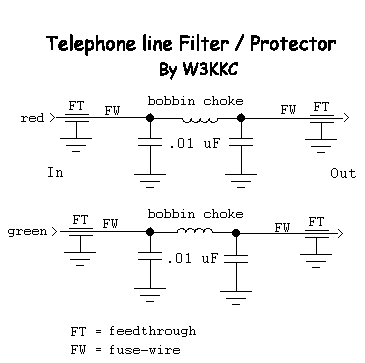
Telephone
Line Filter / Protector
By Kevin Custer W3KKC
Concept:
To build a circuit that will help protect your equipment from lightning
strikes on the phone line. This circuit was actually designed to
reduce or eliminate a very local broadcast AM radio stations signal from
bombarding my parents telephone line, however it also turned out to be
a really good lightning protector.
Construction:
The circuit is built on a piece of unetched double sided PC board measuring
about 2" X 4". I placed "ends" made of the same PC board material
on the 'two inch' sides that are 1" high. This kinda makes a U shaped
chassis, that is long in the middle. I drilled the end boards to
allow 2 solder in feed throughs to be attached side by side, about an inch
apart. These were not feedthrough caps just plain old feed- throughs,
but caps could probably be used if not too many pF. I installed these
on both ends. This allows 2 identical 'paths' to be constructed in
a series circuit from one end to the other. See Circuit Schematic
below for detail.
I obtained 2, 'bobbin chokes' from an old tv set. These chokes have lots of windings and resemble a drop in bobbin of thread but only about half as thick. I have no idea the value of the chokes I used, they were just something that looked good. I supported the bobbin chokes by standing 2, .01 uF. 100 volt ceramic caps with one leg each soldered directly to the PC board just far enough apart so the free legs could support the choke. I did this kinda in-line with the feedthroughs, and with both sides of the circuit. I then tied the feed throughs to each end of the chokes with VERY thin wire, using a single strand from very fine stranded wire. This makes a cheap fuse.
So, now you have two identical sides starting with a series feedthrough going through a fuse wire to a choke / cap to ground. The other side of the choke / cap to ground goes through more fuse wire to the other feedthrough. Since both sides of the device are electrically identical, there is no orientation, as one end is input and the other output, makes no matter which. The key thing for making this device work is to supply it with a Very Good, Short Earth Ground return connected to the PC Cladding somewhere. This ground can be a driven ground or the site's grounding system if one exists. I usually solder a #6 wire right on the PC board with a large soldering gun.
Conclusion:
When lightning strikes the telco line (or near it) the surge is impeded
by the chokes and taken up by the capacitors and fuse wire. When
the device has stopped lightning, it usually blows the input caps, and
fuse wire completely off of the board, as the frog hair wire and caps are
sacrificial devices...so it's a good idea to keep extra caps and fuse wire
handy so it can be rebuilt. Don't place the device somewhere it could
start a fire, or otherwise solder a lid on it.
In the case of this protector, the jump path for lightning comes from the insulation properties of the dielectric in the capacitors. The capacitors are rated at 100 volts and probably holes begin to develop in the dielectric at about 3 to 5 times their rated amount. When this happens, they form a spark gap and short out. At this instant the current capability of the fuse wire is exceeded and burns open due to the path created to earth ground. This is why the ground connection is so important. This effect is compounded by the large inductance from the bobbin chokes which tends to stop the lightning from going any further. Since voltage is what shorts the capacitors, and current is what blows the fuse wire, this device protects from both over voltage and over current.
Since the device is also a filter, it passes voice signals ok, but I wouldn't want to put it on a 56 K modem connection as the high end may be rolled off too far. If this is going to be used on a voice patch only controller without a serial modem interface, you'll be ok.....otherwise the connection may be slower with the protector in-place.
This device may be beneficial to keep RF out of the phone system when using a HF remote base at the repeater site or an HF station at your home.

Copyright June 13, 2000 Kevin K. Custer W3KKC
HTML Copyright June 2000 W3KKC
All Rights Reserved
Questions or Comments? Send them here>
Email Kevin